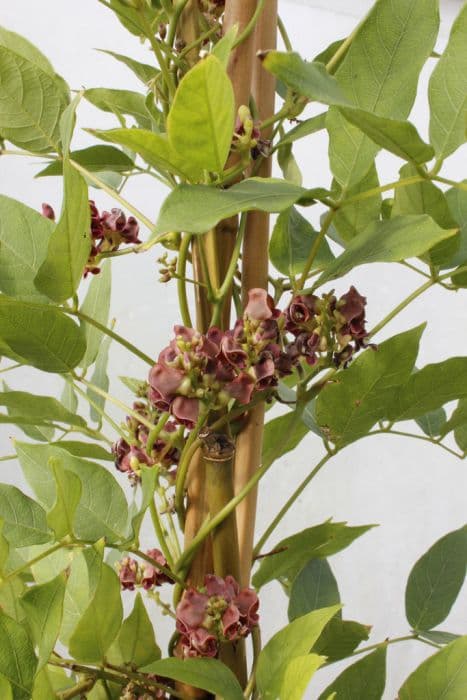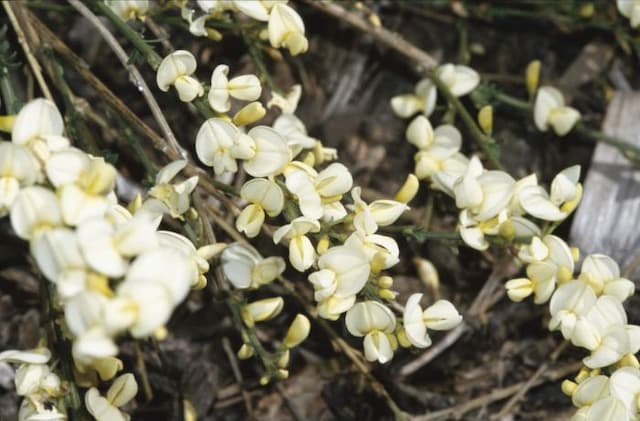Broom Genista 'Porlock'

ABOUT
Genista 'Porlock', commonly known as broom, is a flowering plant that features an abundance of vibrant yellow blossoms. These small but numerous, pea-shaped flowers cluster along the plant's stems, creating bright, eye-catching displays that can cover the broom densely when in full bloom. The foliage of Genista 'Porlock' consists of small, green leaves that are often simple and elongated, giving the plant a fine texture and an overall bushy appearance. The stems of the broom are somewhat angular and slender, and they can create a slightly arching habit, which contributes to the plant's ornamental appeal. During the blooming period, which generally occurs in spring or early summer, the rich yellow flowers contrast beautifully against the green foliage, attracting pollinators such as bees and butterflies to the garden. Beyond the striking floral display, the seed pods that follow, typically in the form of small legumes, provide added interest and texture. When mature, they may crack open to release the seeds inside. The overall impression of Genista 'Porlock' is one of a cheerful and lively plant, which can bring a splash of sunshine to the landscape thanks to its profuse and bright flowers.
About this plant
 Names
NamesFamily
Fabaceae
Synonyms
Porlock Broom
Common names
Genista 'Porlock'.
 Toxicity
ToxicityTo humans
The common name for Genista 'Porlock' is broom. Broom plants contain toxic alkaloids, particularly sparteine and isosparteine, making them poisonous if ingested. The toxicity can cause various symptoms such as nausea, vomiting, diarrhea, and abdominal pain. In severe cases, poisoning can lead to symptoms such as dizziness, weakness, headache, and in some cases can affect the heart's rhythm and rate, potentially leading to more serious complications. It is important to avoid ingesting any parts of the broom plant.
To pets
Broom is toxic to pets due to the presence of alkaloids such as sparteine and isosparteine. If ingested by animals, symptoms of broom poisoning can include vomiting, diarrhea, abdominal pain, and weakness. More severe effects may include changes in heart rate, blood pressure issues, and in extreme cases, it may lead to convulsions or respiratory failure. It is crucial to prevent pets from ingesting any part of the broom plant to avoid these toxic effects.
 Characteristics
CharacteristicsLife cycle
Perennials
Foliage type
Evergreen
Color of leaves
Green
Flower color
Yellow
Height
3-4 feet (0.9-1.2 meters)
Spread
4-6 feet (1.2-1.8 meters)
Plant type
Shrub
Hardiness zones
7
Native area
Europe
Benefits
 General Benefits
General Benefits- Attractive Flowers: Genista 'Porlock' produces bright yellow blooms that add vibrant color to gardens and landscapes.
- Drought Tolerance: Once established, this plant has a good tolerance for drought, making it suitable for xeriscaping or dry climate gardening.
- Low Maintenance: It generally requires minimal care once established, which is beneficial for gardeners seeking low-maintenance plants.
- Erosion Control: Its root system helps stabilize slopes and embankments, thus reducing soil erosion.
- Habitat for Wildlife: The blooms can attract pollinators such as bees and butterflies, providing a beneficial habitat for these creatures.
- Adaptability: Genista 'Porlock' can adapt to a variety of soil types, though it prefers well-drained soils.
- Seasonal Interest: This plant provides seasonal interest with its striking flowers in late spring and its evergreen foliage.
- Compact Growth: It has a relatively compact growth habit, making it suitable for smaller gardens or as part of a mixed border.
 Medical Properties
Medical PropertiesThis plant is not used for medical purposes.
 Air-purifying Qualities
Air-purifying QualitiesThis plant is not specifically known for air purifying qualities.
 Other Uses
Other Uses- The wood of the broom plant can be used for small-scale wood carving or crafting objects such as handles for tools due to its firmness and durability.
- Fibers from broom can be utilised in the production of rough textiles or ropes, especially in traditional or historical contexts.
- Broom has been traditionally used in some regions to make a yellow dye, which was valuable before the advent of synthetic dyes.
- The long, straight stems of broom can be employed as support stakes in horticulture for other plants.
- Genista 'Porlock' can be used in landscape design to prevent soil erosion on slopes due to its root system that stabilizes the ground.
- Its dense foliage can provide shelter and nesting sites for various bird species, thus contributing to maintaining local biodiversity.
- Broom flowers might be used in the craft of natural potpourris due to their fragrance and visual appeal.
- Dried broom branches could be utilized as kindling for fires because they ignite easily and burn hot, making them useful for starting a campfire or a fireplace.
- When pruned properly, the broom plant can also be cultivated as bonsai, providing an unusual aesthetic to this traditional art form.
- The plant's bright yellow flowers can be used to create a vibrant, natural dye for fabrics and yarns in artisanal crafting.
Interesting Facts
 Feng Shui
Feng ShuiThe Broom is not used in Feng Shui practice.
 Zodiac Sign Compitability
Zodiac Sign CompitabilityThe Broom is not used in astrology practice.
 Plant Symbolism
Plant Symbolism- Protection: Genista, commonly known as broom, has historically been associated with protection. In folklore, it was believed to ward off evil spirits and negative energies.
- Purity: The bright yellow flowers of the broom are often linked to cleanliness and purity, possibly due to their association with domestic rituals of sweeping and cleaning.
- Humility: Broom plants grow close to the ground and have a simple, unassuming appearance, which can symbolize an attitude of humility and modesty.
- New Beginnings: As broom plants can quickly colonize bare or disturbed land, they symbolize starting anew and resilience in the face of adversity.
 Water
WaterThe Broom plant (Genista 'Porlock') prefers to be watered moderately, especially during the growing season. Ensure that the soil is well-draining and allow the top layer to dry out slightly before watering again. Typically, watering once a week with about 1 gallon of water should suffice, but this can vary depending on your climate and the time of year. Over-watering can lead to root rot, so it's important not to let the Broom sit in soggy soil. Reduce the frequency of watering in winter when the plant is not actively growing.
 Light
LightBroom plants (Genista 'Porlock') thrive best in full sun conditions, meaning they should receive at least 6 to 8 hours of direct sunlight daily. Place them in a spot where they can enjoy uninterrupted light throughout the day for optimal growth and flower production. They can tolerate partial shade, but flowering and foliage density may be reduced in less than full sun.
 Temperature
TemperatureBroom plants (Genista 'Porlock') are hardy and can tolerate a wide range of temperatures but perform best when the temperature is between 50°F and 70°F. They can survive temperatures as low as 10°F but should be protected from prolonged freezing conditions. High temperatures above 80°F may stress the plant, so ensure some afternoon shade or protection during the hottest part of the day.
 Pruning
PruningBroom plants (Genista 'Porlock') should be pruned to maintain shape and encourage bushiness. Pruning is best done immediately after flowering to avoid cutting off next season's blooms. Typically, this means pruning in late spring or early summer, removing dead flowers and trimming back about one-third of the growth to promote new shoots and a denser habit. Avoid heavy pruning in late fall or winter, as this can damage the plant.
 Cleaning
CleaningNot needed
 Soil
SoilThe Broom 'Porlock' prefers well-draining sandy soil with a pH range of 6.0 to 7.5. A soil mix consisting of two parts sand, one part loam, and one part peat or compost is ideal. Ensure the soil is not too rich in nutrients, which could inhibit flowering.
 Repotting
RepottingBroom 'Porlock' should be repotted every two to three years to refresh the soil and accommodate its growing root system. It's best done in late winter or early spring before new growth starts.
 Humidity & Misting
Humidity & MistingBroom 'Porlock' is tolerant of a wide range of humidity levels and does not require high humidity to thrive. Keeping it in average room humidity or in an outdoor environment is usually sufficient.
 Suitable locations
Suitable locationsIndoor
Place Broom 'Porlock' near a sunny window and water sparingly.
Outdoor
Plant Broom 'Porlock' in full sun and well-draining soil.
Hardiness zone
5-9 USDA
 Life cycle
Life cycleGenista 'Porlock', commonly known as Porlock broom, begins its life cycle when seeds from the mature plant germinate in suitable conditions—warm temperatures and well-drained soil. The seedlings then establish themselves, gradually developing into young plants with a robust root system and foliage. As the plants mature, they enter a vegetative stage, characterized by the growth of woody stems and green leaves, preparing for the reproductive phase. Upon reaching reproductive maturity, Porlock broom produces vibrant yellow flowers, typically in late spring or early summer, which are pollinated by insects, leading to the formation of seed pods. After seed set, the pods dry and release seeds to start a new generation. The plant may enter a period of dormancy during colder months before resuming growth and flowering in the next season, continuing its perennial life cycle.
 Propogation
PropogationPropogation time
Late spring-early summer
The most popular method of propagating Genista 'Porlock', commonly known as Broom, is through semi-hardwood cuttings. This process is generally best undertaken in late summer. To propagate by cuttings, a gardener would select healthy, semi-hardwood stems from the current year’s growth, ensuring each cutting is about 4 to 6 inches (10 to 15 centimeters) long. They should cut just below a leaf node, remove the lower leaves, and dip the cut end into rooting hormone powder to enhance the rooting process. The cutting is then placed into a pot with well-drained soil, watered gently, and covered with a plastic bag or placed in a propagator to maintain high humidity around the cutting. Roots typically develop within a few weeks, at which point the cutting can be gradually acclimated to outside conditions before being planted out in the garden.









